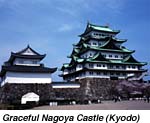
 |
 |

-
Nagoya: Crossroads Between Eastern and Western Japan Nagoya is Japan's third metropolis, historically linking Tokyo to the east and Osaka to the west. It's the capital of Aichi Prefecture and the economic and political focus of central Japan. Influenced by both Tokyo and Osaka, Nagoya is a crossroads where many roads, rivers, and railroads intersect. These things have helped make Nagoya one of Japan's most important cities.
Southeast of the city is Toyota, where Japan's leading automobile company bearing its name is headquartered. And northeast of Nagoya is the city of Seto, Japan's biggest center of ceramic production. It is in Seto that the 2005 World Exposition will be held under the theme of "Beyond Development."
Japan has a famous, ancient highway known as the Tokaido ("Eastern Sea Road"), which dates back to the seventh century. For centuries it served as the primary link between Japan's ancient capital, Kyoto, and what is now Tokyo.
Nagoya was a major stop on this road, where it connected with another major highway, the Nakasendo ("Middle Mountain Road"). The Nakasendo led to Nagano City. Today, the 250-kilometer (155-miles) journey from Nagoya to Nagano takes just three and a half hours by car.
Nagoya is also a major hub for ocean transport. Off its coast flows a current called the Kuroshio ("Black Stream"), which starts east of the Philippines and moves northeast, flowing past Japan's Pacific coast. The Kuroshio is the largest current in the seas around Japan. It's so strong that it carries coconuts all the way from southeast Asia to Japan! This powerful current can carry ships, too.
Way back in the year 797, people from what we know today as the countries of Malaysia and Indonesia arrived in Nagoya by boat, carried to Japan by the Kuroshio. They brought with them a jar of cotton seeds. Ever since that time, cotton has been one of Aichi Prefecture's leading products.

RETURN TO
QUESTION
LOOK AT ANSWER